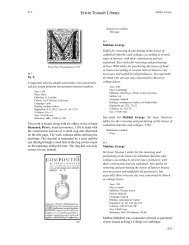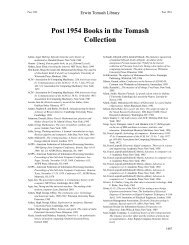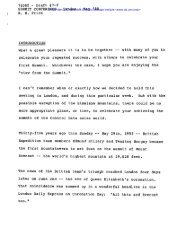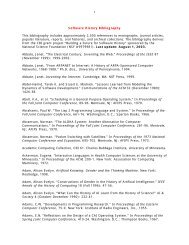B chapter.indd - Charles Babbage Institute - University of Minnesota
B chapter.indd - Charles Babbage Institute - University of Minnesota
B chapter.indd - Charles Babbage Institute - University of Minnesota
Create successful ePaper yourself
Turn your PDF publications into a flip-book with our unique Google optimized e-Paper software.
188<br />
Erwin Tomash Library<br />
Brahe, Tycho Brahe, Tycho<br />
B 223<br />
days, and this discrepancy forced him to conclude that<br />
the tables were seriously flawed.<br />
Brahe understood that it would require an extended<br />
program <strong>of</strong> observations, made with the best instruments<br />
available, to correct the tables. It took more than a decade<br />
for him to obtain the necessary facilities and financial<br />
support, but in early 1576, King Frederick II <strong>of</strong>fered<br />
Brahe the life-long use <strong>of</strong> the island <strong>of</strong> Hven in the Danish<br />
Sound for the erection <strong>of</strong> an observatory there to be fitted<br />
with the most accurate instruments to be had. The <strong>of</strong>fer<br />
brought with it sources <strong>of</strong> income, which, when added<br />
to Brahe’s not inconsiderable means, meant that Brahe<br />
could build the finest observatory in the world.<br />
Uraniborg, B 223<br />
Armillary sphere, B 223<br />
This book describes Brahe’s observatory, Uraniborg, on<br />
the island <strong>of</strong> Hven and gives a catalog <strong>of</strong> the instruments<br />
he used to obtain the precise measurements that allowed<br />
Kepler to determine planetary orbits. The work also<br />
contains Brahe’s autobiography and a description <strong>of</strong> how<br />
he divided his scales with transverse lines in order to make<br />
more accurate observations. Brahe was the last <strong>of</strong> the<br />
great observational astronomers before the invention <strong>of</strong><br />
the telescope, although others after him also used nakedeye<br />
sights on their instruments. Although dated after<br />
Brahe’s death, this work was first published privately in<br />
1598 in a very limited edition <strong>of</strong> about forty copies. This<br />
1602 edition was the first sold commercially and is today<br />
the only one generally available. The engraving <strong>of</strong> the<br />
equatorial armillary sphere on C6 appears for the first<br />
time in this edition, replacing a woodcut, and the title<br />
page has an engraved portrait <strong>of</strong> Brahe, also replacing<br />
a woodcut.<br />
The instruments described here are unlike those shown<br />
in most other instrument volumes <strong>of</strong> this period. These<br />
are precision instruments <strong>of</strong> the highest caliber, whereas<br />
many <strong>of</strong> the other works <strong>of</strong> the time describe instruments<br />
that could be obtained by amateur gentlemen interested<br />
in astronomy.<br />
Illustrations available:<br />
Title page (portrait <strong>of</strong> Brahe)<br />
Diagonally divided scale<br />
Armillary sphere<br />
Uraniborg – Brahe’s “heavenly castle” observatory<br />
Large quadrant







